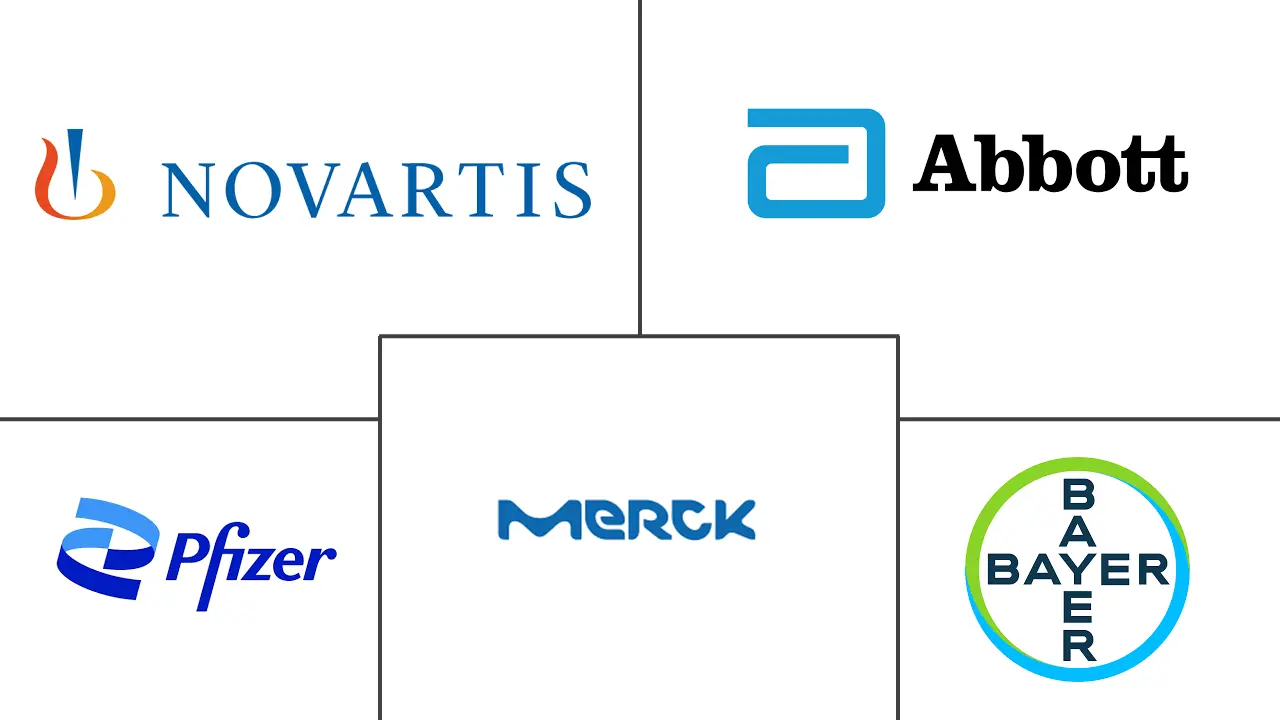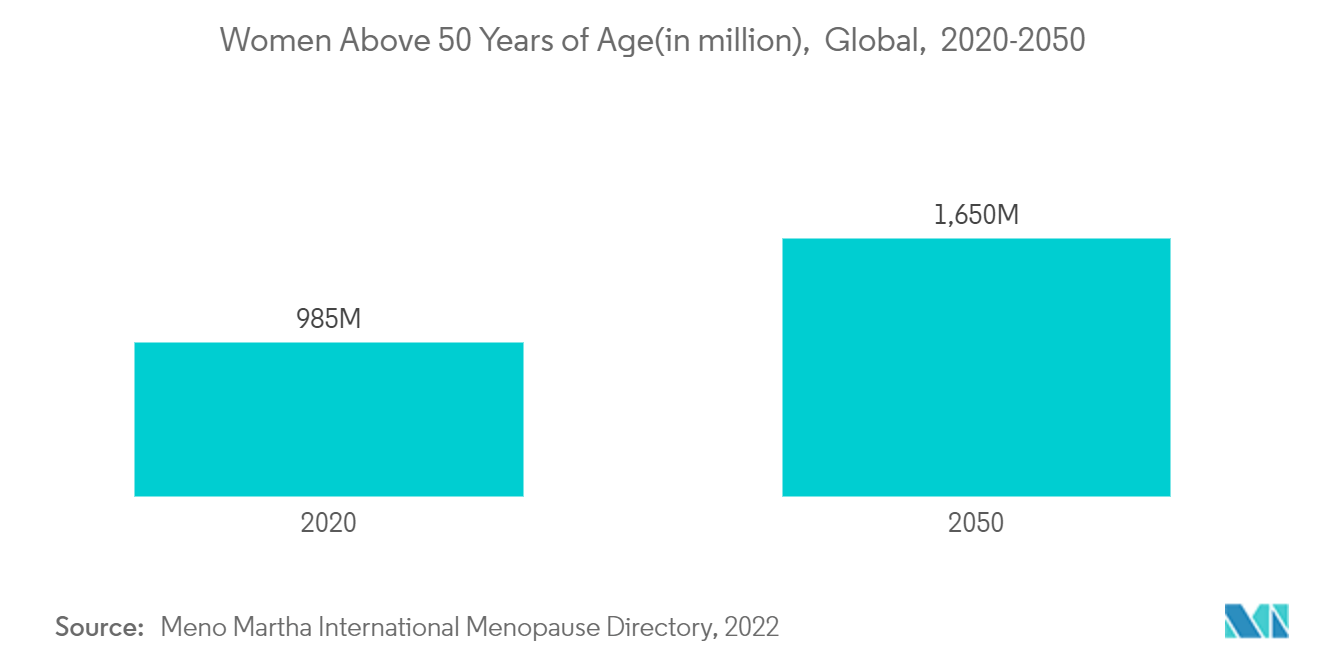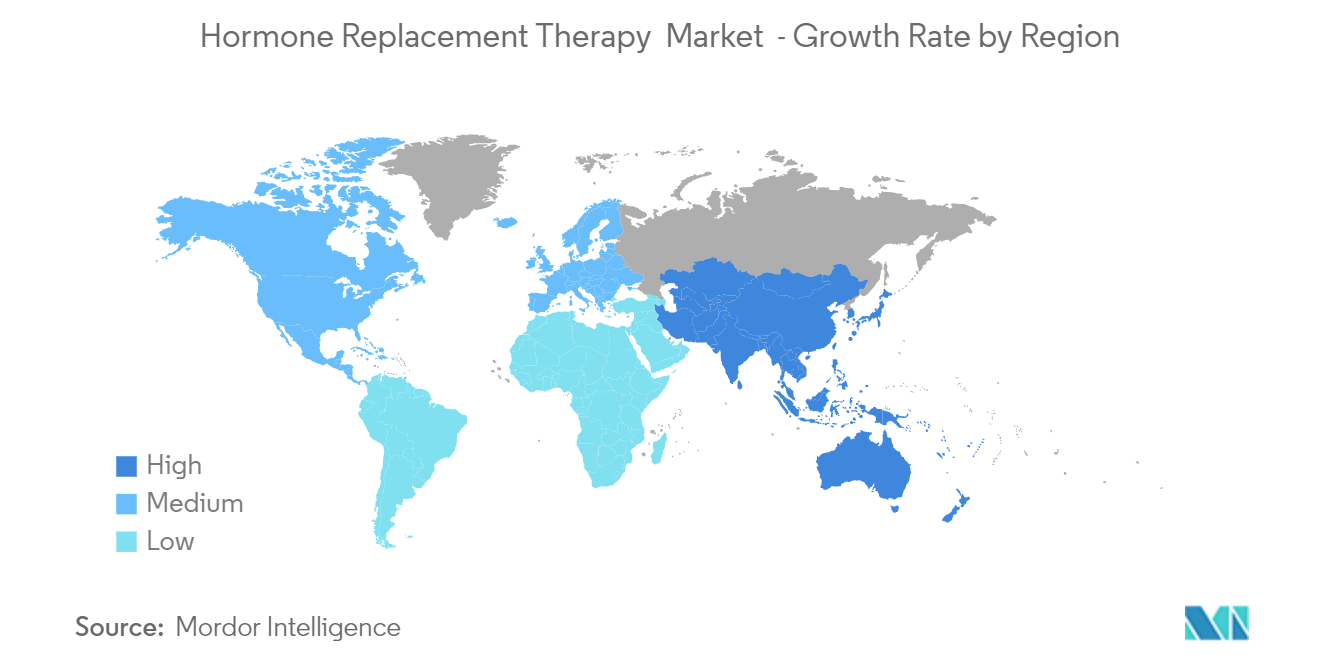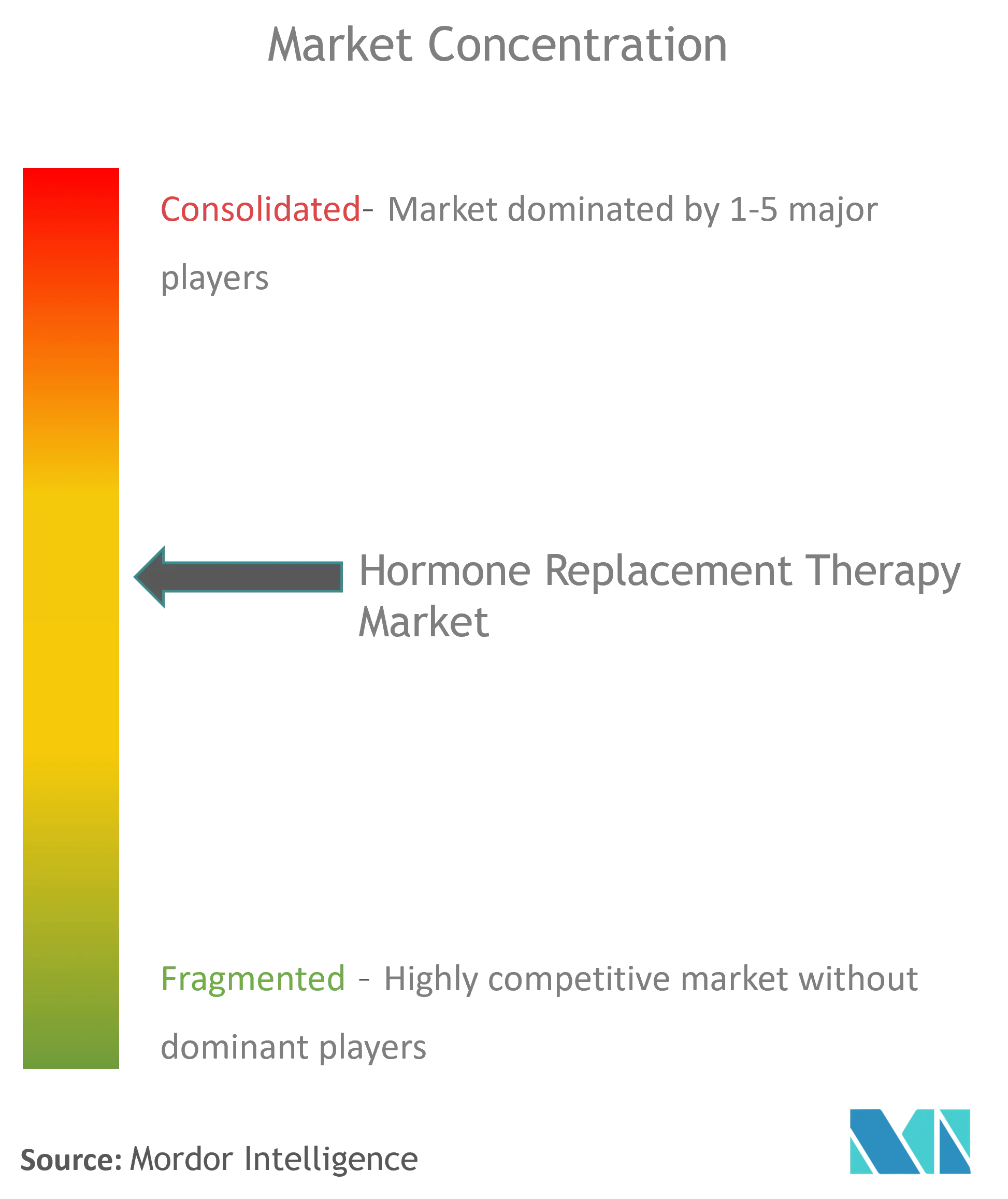Hormone Replacement Therapy (HRT) Market Size

| Study Period | 2019 - 2029 |
| Base Year For Estimation | 2023 |
| CAGR | 7.59 % |
| Fastest Growing Market | Asia Pacific |
| Largest Market | North America |
| Market Concentration | High |
Major Players
*Disclaimer: Major Players sorted in no particular order |
Hormone Replacement Therapy (HRT) Market Analysis
The hormone replacement therapy market with a CAGR of 7.59% during the forecast period (2022-2027).
The COVID-19 pandemic is expected to have a significant impact on the home replacement therapy market. An increasing number of research studies have been carried out to find the application of hormone replacement therapy in COVID-19 infected patients. For instance, as per the research article titled 'Hormone Replacement Therapy May Reduce the Risk of COVID-19 Death in Post-Menopausal Women' published in February 2022, the risk of dying from COVID-19 may be lower in post-menopausal women who have greater estrogen levels because of hormone replacement therapy (HRT) than in those who have natural estrogen levels. Hence, due to the aforementioned factors, hormone replacement therapy is expected to play a promising role in developing novel therapeutics for the effective treatment of SARS-CoV2 virus infection, which may lead to the growth of the studied market during the pandemic.
Certain factors that are positively affecting the hormone replacement therapy (HRT) market growth are increasing awareness of post-menopausal issues among women, rise in drug development with novel delivery systems, and hormonal imbalance disorders with the rising geriatric population. According to World Population Prospects 2022 report-United States, the latest projections by the United Nations suggest that the global population could grow to around 8.5 billion in 2030, 9.7 billion in 2050, and 10.4 billion in 2100. With various kinds of hormonal changes, the female body predominantly gets affected by the natural process of aging, leading to abnormalities and diseases. Some of the common problems include weight gain, memory decline, fatigue, low libido, aging appearance, and muscle loss.
The most frequently reported consequence of age-related hormonal changes occurs in cases related to menopause. The global average onset age for menopause among women is approximately 50 years. In women, by the age of 50 years and above, the production levels of estrogen and progesterone decrease significantly. The decrease in production levels of estrogen and progesterone is compensated by the pituitary gland, with the increased production of follicle-stimulating hormone (FSH). This is physically manifested in women in the form of post-menopause symptoms, which include flush. These factors associated with age lead to the rising demand for HRT, thus driving the market studied.
Additionally, the growing R&D activities by the key players for the discovery of novel therapeutics to treat hormonal imbalances and rising product approvals are expected to aid in the growth of the studied market over the forecast period. However, the high cost of hormone replacement therapy and the risk of developing cancers with HRTs are anticipated to hamper the market growth globally.
Hormone Replacement Therapy (HRT) Market Trends
This section covers the major market trends shaping the Hormone Replacement Therapy Market according to our research experts:
The Menopause Segment is Expected to Register a Healthy CAGR over the Forecast Period
Menopause is the time that marks the end of women's menstrual cycles. It is diagnosed after a woman had gone 12 months without a menstrual period. Menopause can happen at an age ranging between 40 to 50 years. Menopause is a natural biological process. Hormone replacement therapy improves the quality of life and prolongs life for many elderly women, whether it is initiated at menopause or much later. The therapy helps elderly women maintain their estrogen levels.
This application is expected to rise in the future as the geriatric population globally is increasing. As women reach the end of the reproductive stage, the estrogen levels lower, leading to mood swings, depression, anxiety, and certain physical changes. Hormone replacement therapy, with estrogen hormone, plays a vital role in combating the complications associated with menopause in the aging women population.
According to the research article titled 'Prevalence and risk factors for menopausal symptoms in middle-aged Chinese women: a community-based cross-sectional study' published in November 2021, the prevalence of menopausal symptoms was 9.3% (303/3,256), 23.9% (293/1,227), and 21.5% (405/1,881) in the reproductive stage, menopausal transition, and postmenopausal stage. Similarly, an article titled 'The Demographic Changes of Menopausal and Geripausal Women in Korea' published in February 2021, in 2030, one-fourth of elderly women who are female is expected to be postmenopausal, and nearly half of females will be. The percentage of postmenopausal women in the total female population will rise to 59.8% by 2060. Hence, a combination therapy of levonorgestrel releasing-intrauterine system (LNG-IUS) with oral or percutaneous estrogen, low-dose combined oral contraceptives (COCs), and estrogen-progestogen therapy (EPT) is usually suggested for treating the symptoms of menopause during the menopausal transition.
Additionally, the rise in product approvals is expected to drive the segment growth. For instance, in September 2021, Theramex announced the approval of Bijuva / Bijuve across Europe and the UK. Bijuva, body-identical hormone therapy treatment (HRT) for estrogen deficiency symptoms in postmenopausal women with an intact uterus and at least 12 months since last menses, which combines estradiol and progesterone in a single daily oral capsule. Similarly, in December 2020, the US FDA approved the Myovant Sciences' Orgovyx (relugolix), which is an orally administered treatment that works by blocking the pituitary gland from making hormones called luteinizing hormone and follicle-stimulating hormone, thus leading to the reduction in the amount of testosterone produced by the testicles. This aids in the treatment of adult patients with advanced prostate cancer.
Thus, owing to the aforementioned factors, the menopause indication segment is expected to witness significant growth over the forecast period.

North America Holds the Largest Market Share, and it is Expected to do the Same Over the Forecast Period
The rising geriatric population is one of the primary factors responsible for the growth of the hormonal replacement therapy market in the North American region, especially in the United States and Canada.
According to the National Institutes of Health (NIH), almost half of all post-menopausal women in the United States reported using HRT at least once in their lives. Also, according to a research article published in Statpearls, 2021, nearly 1.3 million American women enter the menopause phase each year in the United States. The conjugated equine estrogens (CEE)/bazedoxifene tablet, a combination of estrogen and a selective estrogen receptor modulator, is available in the United States for menopausal VMS treatment and osteoporosis prevention.
Additionally, as per the American Thyroid Association (ATA), data updated in 2022, more than 12% of the population in the United States is predicted to experience a thyroid disorder during their lifetime, and nearly 20 million Americans are affected by some form of thyroid disease every year. Thus, the high incidence of thyroid hormone imbalance among the population in the United States is expected to boost the studied market in the region.
Also, in June 2022, Astellas Pharma Inc. announced a New Drug Application (NDA) for fezolinetant submitted to the U.S. Food and Drug Administration (FDA). Fezolinetant is an investigational oral, nonhormonal compound seeking approval for the treatment of moderate to severe vasomotor symptoms (VMS) associated with menopause. VMS, characterized by hot flashes and/or night sweats, are common symptoms of menopause. Thus, the high trend of product approvals is also expected to drive the studied market in the region.
Overall, the market for HRT in North America is scheduled for high growth over the forecast period. The major drivers of this market are expected to increase the adoption of HRT among women for both post-menopausal and menopause management.

Hormone Replacement Therapy (HRT) Industry Overview
The market is moderately competitive, with few major players dominating the market globally. The key companies are Abbott Laboratories, Bayer AG, Merck KGaA, Novartis AG, and Pfizer Inc. However, there are efforts being made by new players to enter the hormone replacement therapy market. Additionally, the key players are focused on global product portfolio expansion through acquisitions and collaborations with companies that complement their portfolios. For instance, in December 2020, the US FDA approved Thyquidity (levothyroxine) oral solution, of VistaPharm, for replacement therapy of primary (thyroidal), secondary (pituitary), and tertiary (hypothalamic) congenital or acquired hypothyroidism, along with an additional approval as an adjunct to surgery and radioiodine therapy in the management of thyrotropin-dependent well-differentiated thyroid cancer.
Hormone Replacement Therapy (HRT) Market Leaders
-
Abbott Laboratories
-
Novartis AG
-
Pfizer Inc.
-
Merck KGaA
-
Bayer AG
*Disclaimer: Major Players sorted in no particular order

Hormone Replacement Therapy (HRT) Market News
- In June 2022, Halozyme Therapeutics, Inc. announced the commercial launch of TLANDO (testosterone undecanoate), an oral treatment indicated for testosterone replacement therapy in adult males for conditions associated with a deficiency or absence of endogenous testosterone.
- In February 2022, Pfizer Inc. and OPKO Health, Inc. announced that the European Commission has granted marketing authorization for the next-generation long-acting recombinant human growth hormone NGENLA, a once-weekly injection to treat children and adolescents from 3 years of age with growth disturbance due to insufficient secretion of growth hormone.
Hormone Replacement Therapy (HRT) Market Report - Table of Contents
1. INTRODUCTION
- 1.1 Study Assumptions and Market Definition
- 1.2 Scope of the Study
2. RESEARCH METHODOLOGY
3. EXECUTIVE SUMMARY
4. MARKET DYNAMICS
- 4.1 Market Overview
-
4.2 Market Drivers
- 4.2.1 Increasing Awareness of Post-menopausal Issues among Women
- 4.2.2 Rise in Drug Development with Novel Delivery Systems
- 4.2.3 Hormonal Imbalance Disorders with Rising Geriatric Population
-
4.3 Market Restraints
- 4.3.1 High Cost of Hormone Replacement Therapy
- 4.3.2 Substantial Risk of Cancer Associated with Hormone Replacement Therapy
-
4.4 Porter's Five Forces Analysis
- 4.4.1 Threat of New Entrants
- 4.4.2 Bargaining Power of Buyers/Consumers
- 4.4.3 Bargaining Power of Suppliers
- 4.4.4 Threat of Substitute Products
- 4.4.5 Intensity of Competitive Rivalry
5. MARKET SEGMENTATION
-
5.1 By Therapy
- 5.1.1 Estrogen Hormone Replacement
- 5.1.2 Growth Hormone Replacement
- 5.1.3 Thyroid Hormone Replacement
- 5.1.4 Testosterone Replacement
-
5.2 By Route of Administration
- 5.2.1 Oral
- 5.2.2 Parenteral
- 5.2.3 Other Routes of Administration
-
5.3 By Indication
- 5.3.1 Menopause
- 5.3.2 Hypothyroidism
- 5.3.3 Growth Hormone Deficiency
- 5.3.4 Other Indications
-
5.4 Geography
- 5.4.1 North America
- 5.4.1.1 United States
- 5.4.1.2 Canada
- 5.4.1.3 Mexico
- 5.4.2 Europe
- 5.4.2.1 Germany
- 5.4.2.2 United Kingdom
- 5.4.2.3 France
- 5.4.2.4 Italy
- 5.4.2.5 Spain
- 5.4.2.6 Rest of Europe
- 5.4.3 Asia-Pacific
- 5.4.3.1 China
- 5.4.3.2 Japan
- 5.4.3.3 India
- 5.4.3.4 Australia
- 5.4.3.5 South Korea
- 5.4.3.6 Rest of Asia-Pacific
- 5.4.4 Middle-East and Africa
- 5.4.4.1 GCC
- 5.4.4.2 South Africa
- 5.4.4.3 Rest of Middle-East and Africa
- 5.4.5 South America
- 5.4.5.1 Brazil
- 5.4.5.2 Argentina
- 5.4.5.3 Rest of South America
6. COMPETITIVE LANDSCAPE
-
6.1 Company Profiles
- 6.1.1 Abbott Laboratories
- 6.1.2 Bayer AG
- 6.1.3 Eli Lilly and Company
- 6.1.4 F. Hoffmann-La Roche
- 6.1.5 Merck KGaA
- 6.1.6 Mylan NV
- 6.1.7 Novartis AG
- 6.1.8 Novo Nordisk AS
- 6.1.9 Pfizer Inc.
- 6.1.10 Amgen
- 6.1.11 Genentech Inc.
- 6.1.12 Abbvie Inc. (Allergan PLC)
- 6.1.13 Teva Pharmaceutical Industries Ltd
- 6.1.14 Dr. Reddy's Laboratories Ltd
- *List Not Exhaustive
7. MARKET OPPORTUNITIES AND FUTURE TRENDS
8. IMPACT OF COVID-19 ON THE MARKET
** Subject To AvailablityHormone Replacement Therapy (HRT) Industry Segmentation
As per the scope of the report, hormone replacement therapy (HRT) is a treatment technique for replacing and/or replenishing hormones in the human body, which are at inadequate levels than those required for the normal physiology of the human body. The most prominent application of HRT is in the treatment of symptom alleviation of menopause. The hormone replacement therapy market is segmented by therapy (estrogen hormone replacement, growth hormone replacement, thyroid hormone replacement, and testosterone replacement), route of administration (oral, parenteral, and other routes of administration), indication (menopause, hypothyroidism, growth hormone deficiency, and other indications), and geography (North America, Europe, Asia-Pacific, Middle-East and Africa, and South America). The market report also covers the estimated market sizes and trends for 17 different countries across major regions, globally. The report offers the value (USD million) for all the above segments.
| By Therapy | Estrogen Hormone Replacement | |
| Growth Hormone Replacement | ||
| Thyroid Hormone Replacement | ||
| Testosterone Replacement | ||
| By Route of Administration | Oral | |
| Parenteral | ||
| Other Routes of Administration | ||
| By Indication | Menopause | |
| Hypothyroidism | ||
| Growth Hormone Deficiency | ||
| Other Indications | ||
| Geography | North America | United States |
| Canada | ||
| Mexico | ||
| Geography | Europe | Germany |
| United Kingdom | ||
| France | ||
| Italy | ||
| Spain | ||
| Rest of Europe | ||
| Geography | Asia-Pacific | China |
| Japan | ||
| India | ||
| Australia | ||
| South Korea | ||
| Rest of Asia-Pacific | ||
| Geography | Middle-East and Africa | GCC |
| South Africa | ||
| Rest of Middle-East and Africa | ||
| Geography | South America | Brazil |
| Argentina | ||
| Rest of South America |
Hormone Replacement Therapy (HRT) Market Research FAQs
What is the current Global Hormone Replacement Therapy Market size?
The Global Hormone Replacement Therapy Market is projected to register a CAGR of 7.59% during the forecast period (2024-2029)
Who are the key players in Global Hormone Replacement Therapy Market?
Abbott Laboratories, Novartis AG, Pfizer Inc., Merck KGaA and Bayer AG are the major companies operating in the Global Hormone Replacement Therapy Market.
Which is the fastest growing region in Global Hormone Replacement Therapy Market?
Asia Pacific is estimated to grow at the highest CAGR over the forecast period (2024-2029).
Which region has the biggest share in Global Hormone Replacement Therapy Market?
In 2024, the North America accounts for the largest market share in Global Hormone Replacement Therapy Market.
What years does this Global Hormone Replacement Therapy Market cover?
The report covers the Global Hormone Replacement Therapy Market historical market size for years: 2019, 2020, 2021, 2022 and 2023. The report also forecasts the Global Hormone Replacement Therapy Market size for years: 2024, 2025, 2026, 2027, 2028 and 2029.
Hormone Replacement Therapy (HRT) Industry Report
Statistics for the 2024 Hormone Replacement Therapy (HRT) market share, size and revenue growth rate, created by Mordor Intelligence™ Industry Reports. Hormone Replacement Therapy (HRT) analysis includes a market forecast outlook to 2029 and historical overview. Get a sample of this industry analysis as a free report PDF download.



